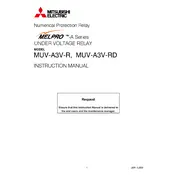Mitsubishi MUV-A3V-R Instruction Manual


To install the Mitsubishi MUV-A3V-R Relay, ensure the power is off. Mount the relay securely in the designated panel or enclosure. Connect the wiring according to the schematic provided in the manual, ensuring all connections are tight and secure. Finally, switch the power back on and test the relay function.
Check the power supply to ensure the relay is receiving the correct voltage. Verify all connections are correct and secure. Inspect the relay for any visible damage. If the issue persists, consider replacing the relay or consulting a professional technician.
Regular maintenance should be performed every 6 to 12 months. This includes checking connections, cleaning any dust or debris, and testing the relay's operation to ensure it functions correctly.
The Mitsubishi MUV-A3V-R Relay is not specifically designed for outdoor use. If outdoor usage is necessary, ensure it is housed in a weatherproof enclosure to protect it from moisture and extreme temperatures.
Signs that the relay may need replacement include frequent tripping, failure to switch, audible humming or buzzing, and visible signs of damage or burning.
To reset the relay, first ensure the fault condition is cleared. Then, turn off the power supply, wait for a few seconds, and turn it back on. The relay should reset once the power is restored.
To test the relay, use a multimeter to check the coil resistance and ensure it's within specifications. You can also simulate a load condition to see if the relay activates and deactivates as expected.
Ensure the relay is installed in a well-ventilated area and the load does not exceed its rated capacity. Check for any obstructions or faulty wiring that might cause overheating. If overheating persists, replace the relay.
Yes, the Mitsubishi MUV-A3V-R Relay can be used for motor control applications, provided the motor's specifications are within the relay's rated capacity. Always consult the relay's technical datasheet for compatibility.
When handling the relay, ensure you are grounded to prevent electrostatic discharge. Use insulated tools, and handle the relay by its body rather than the terminals to avoid damage.